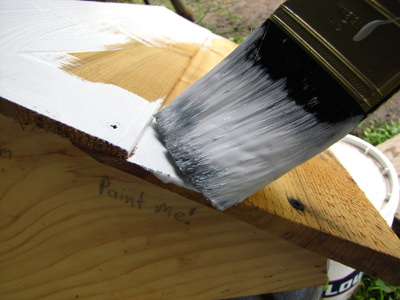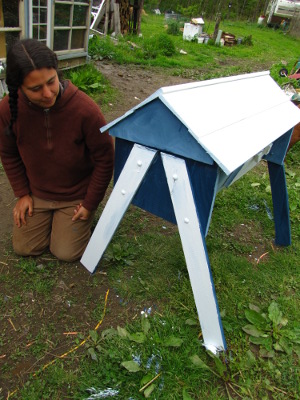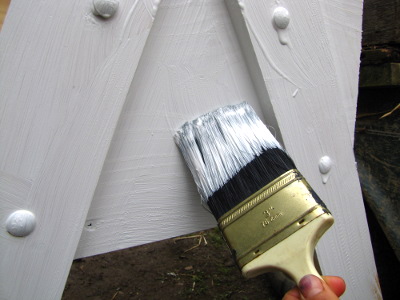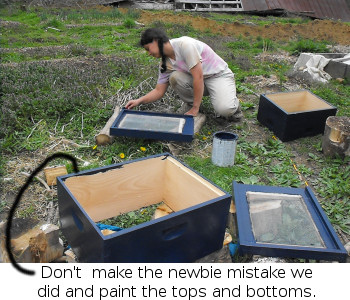
How to paint a bee hive
 Even
though our Easy Hive came with hand-written
instructions straight out of Alice in
Wonderland, the
first question I researched was not how but whether to paint my new
hive.
Even
though our Easy Hive came with hand-written
instructions straight out of Alice in
Wonderland, the
first question I researched was not how but whether to paint my new
hive.
Should
I paint my hive?
The question isn't as
crazy as it sounds --- after all, honeybees had been living happily in
unpainted trees for generations before we took them under our
wing. It turns out the reason we paint our hives has more to do
with the beekeeper than the bees. Unpainted hives tend to rot
sooner, so we add paint to the outside as a waterproofing layer.
In some cases, you may
not need to waterproof your hive at all. In addition to our new top bar hive, we're also trying out a Warre hive this year, and the version
we bought is made out of Western Red Cedar. Cedar and redwood
hives are naturally rot resistant, so many beekeepers leave the wood
completely untreated. We'll probably follow suit since the hives
were back-ordered and are due to arrive on the same day as our
bees. (Yikes!)
 What
should I paint onto my hive?
What
should I paint onto my hive?
Cheaper lumber is
usually soft pine, and will rot pretty quickly if not waterproofed in
some way, so we chose to protect our top bar hive. You can use
exterior latex paint, raw linseed oil (not boiled or the chemicals will
affect your bees), tung oil, or a heated mixture of linseed oil and
beeswax. I wanted to try raw linseed oil since I suspected an
oiled hive would outgas moisture better than a painted hive, but none
of our local stores carried the item, so we went with paint.
What
color should I paint my hive?
The most common question
you hear from new beekeepers is --- what color
should I paint my hive?
The traditional answer is "white", but the real answer is a bit more
complex. Bees don't particularly care what color their hive is,
but pale hives will reflect the sun and keep the colony from
overheating in the winter. On the other hand, if you live in a
cold climate, you might want to soak up the sun's rays, in which case
you should choose a dark color.
If you're going to have
several hives close to each other, it's a good idea to paint each one
with a different color and/or pattern to prevent the common problem of
bees getting lost and going home to the wrong hive. In apiaries
with rows of identical white hives, beekeepers notice that the colonies
on the ends tend to be stronger than those in the middle of the line,
due to the tendency of worker bees to "drift" --- the workers think
they're going home, but ending up in the next hive over. This
issue is less relevant if you are scattering hives around a complex
landscape, and bees are unlikely to drift between different styles of
hives.
How
do I paint my hive?
 Assuming you've chosen to use
paint to waterproof your hive, your next choice is whether to add a
primer underneath, or just to use multiple layers of paint. If
it's going to bother you when you can see a bit of wood grain beneath
your paint, go ahead and paint on two layers of primer (drying in
between), then three layers of paint. Most beekeepers skip the
primer, though, and simply apply two layers of paint. (If you're
using a waterproofing oil, don't use a primer.)
Assuming you've chosen to use
paint to waterproof your hive, your next choice is whether to add a
primer underneath, or just to use multiple layers of paint. If
it's going to bother you when you can see a bit of wood grain beneath
your paint, go ahead and paint on two layers of primer (drying in
between), then three layers of paint. Most beekeepers skip the
primer, though, and simply apply two layers of paint. (If you're
using a waterproofing oil, don't use a primer.)
 No matter which type of
waterproofing you choose, you should apply it only to the outside
surfaces of the hive, both to keep the chemicals away from the bees and
because your livestock will prefer to coat the inside of their hive
with disease-resistant propolis instead. Most beekeepers
recommend that you don't paint the top and bottom edges of Langstroth
hive bodies since paint on these surfaces tends to stick together when
the boxes meet. The rule of thumb is --- paint where rain falls
or splashes, not where bees walk or wood joins.
No matter which type of
waterproofing you choose, you should apply it only to the outside
surfaces of the hive, both to keep the chemicals away from the bees and
because your livestock will prefer to coat the inside of their hive
with disease-resistant propolis instead. Most beekeepers
recommend that you don't paint the top and bottom edges of Langstroth
hive bodies since paint on these surfaces tends to stick together when
the boxes meet. The rule of thumb is --- paint where rain falls
or splashes, not where bees walk or wood joins.
My last tip is --- try
to paint your hive several days before the bees arrive! Bees
don't like chemicals of any kind and that new paint smell isn't going
to help them settle in (and stay healthy.)
I've seen some beautiful
photos on the internet of uniquely painted bee hives. If you've
gone the extra mile to make your ladies' home stylish, I hope you'll
leave a link or photo in the comments!
Want more in-depth information? Browse through our books.
Or explore more posts by date or by subject.
About us: Anna Hess and Mark Hamilton spent over a decade living self-sufficiently in the mountains of Virginia before moving north to start over from scratch in the foothills of Ohio. They've experimented with permaculture, no-till gardening, trailersteading, home-based microbusinesses and much more, writing about their adventures in both blogs and books.
Want to be notified when new comments are posted on this page? Click on the RSS button after you add a comment to subscribe to the comment feed, or simply check the box beside "email replies to me" while writing your comment.

Looks like Everett beat me to mentioning the cedar roofs on his hives! I probably didn't have to paint them, but since I was painting everything else, I went for it. We're actually thinking of following Daddy's advice too and putting a layer of flashing on the way they do on Langstroth covers, just for safety.
I hope I didn't make it sound like I thought the Easy Hives were made of cheaper lumber than other hives. I reread my post and it sounded a bit like that.... For the record, any hive you buy that's not specifically listed as being made out of some other kind of lumber is almost certainly pine.
For the record, any hive you buy that's not specifically listed as being made out of some other kind of lumber is almost certainly pine.
What chemicals are you afraid of with boiled linseed oil? There are usually some metallic salts in the oil to catalyze the drying reaction, but that would be only a very small amount, and they wouldn't evaporate. Some boilded linseed oil may contain petroleum based solvents to make it thinner. But those should evaporate relatively quickly. And wood also naturally contains solvents (terpenes and sometimes n-heptane) in its resin!
But even water based paints contain some solvents. And for outside use I'd stil recommend solvent-borne (a.k.a oil-based) paints because they tend to last longer.
As a rule, latex based paints are not very suitable for outside use.
Roland --- I actually don't know the specifics on chemicals in boiled linseed oil --- I've just been reading beekeeping forums that recommend against it. They could be overreacting, but I figure it's better to be safe than sorry....
The exterior latex paint we used on our other hives has held up quite well outside. Presumably they do something to the exterior grade to make it more likely to handle the weather?
Basically I think it's impossible to answer your question conclusively.
If you allow the paint to dry (cure) properly in a well-ventilated area, so that any solvents have time to evaporate, those shouldn't bother the bees much. And well-cured paint shouldn't release much uncured compounds. As long as the sun doesn't break down the paint binder (the paint looses its shine and starts to give off dust, known as "chalking") there should not be much coming out of the paint.
If honeybees in the wild can nest in resinous trees, boiled linseed oil diluted with odorless mineral spirits should not harm them, I'd think. Natural turpentine is generally considered as more toxic and more flammable than odorless mineral spirits.
I use one coat of primer plus two coats of paint. I use exterior grade latex.
For a pic of a hive body I painted see below:
http://weekendhomestead.net/posts/homestead-updates/